
Are Pacifiers Good and Safe for Babies?
When used in moderation, pacifiers, often called paci or binky, can be an optimal means to ease your distressed child. The sucking action stimulates reflexes by the same name. It is an infant's innate calming mechanism. Now, I know most parents are concerned about nipple confusion. The trick to the game is to introduce the pacifier once breastfeeding is well established.It can be an excellent tool to reduce the risk of Sudden Infant Death Syndrome (SIDS). Parents are often encouraged to hand their young ones the binky before they go to sleep. While reinsertion after it falls off is discouraged, it is said that the mouth position aids in preventing the occurrence. Furthermore, pacifiers also relieve the air pressure pain in children during flights. Making it a logical choice for parents who enjoy going on trips with their babies.
Reasons for Baby To Not Take A Pacifier
If your child is averse to the binky, then it is not necessary that they hate the object altogether. It simply doesn’t serve its purpose for them. For most parts, children reject a binky due to factors related to its material, shape, or size. Another reason could be that they're hungry or in need of comfort that can only be provided by you, and the binky is not tending to their needs optimally. Many parents find that silicone pacifiers are the most sought-after material for their young ones. And that they will have to go back and forth with the sizes and shapes of the pacifier to choose an optimal one for their child. A trial and error, so to speak, but hey, when has anything been easy with kids? We are kidding, of course.
How To Soothe a Baby that Won't Take a Pacifier?
Before losing all faith in the binky, why don’t you give these methods a try:
- At most times the problem lies with the material or the size of the pacifier, as mentioned before. You may want to focus on whether the size of the pacifier, is not too overwhelming for your child. You can also attempt to introduce ones with varied shapes. Some of your options include round, flat, bulb, and orthodontic pacifiers.
- Try handing the pacifier to your child, dipped in something that he is familiar with, like breast milk or formula. The known taste can help them take to the object better.
- You can employ tricks like pulling on the binky rather than pushing it into their mouths, which may initiate a pulling-back response, eventually encouraging them to suck on it. Another trick would be to introduce the pacifier as you imitate breastfeeding. Your child may in turn, instinctively open their mouth for the binky.
Now if these methods do not work, here are some alternatives you can employ:
- Make use of the age-old technique of swaddling your baby. The practice can help soothe pain and discomfort, encouraging your child to get sound sleep.
- You can try rocking them back and forth. Research suggests that the motion, along with your close proximity, can help regulate their heart rate and cause a decrease in crying and body movement. If your child seems unconsolable, you may even attempt skin-to-skin contact to further boost the sense of safety.
- You can even resort to handing them a bottle of breastmilk or warm formula milk to soothe them.
- Some children may even take to sucking on your finger. Although it may be painful for the caregiver during longer periods of distress if they are teething.
- You can even give white noise machines, a warm bath and body massage a try during this time to soothe your child and provide them comfort.
It is important to note that a pacifier is simply a tool to help your child soothe; it is not a necessity that your child grow to use it. Trust your instincts and watch for cues of discomfort. If you notice any, immediately take action to relieve them. Trust the process and be patient with your child as they learn to process and regulate their emotions. Happy Parenting!












LEAVE A COMMENT